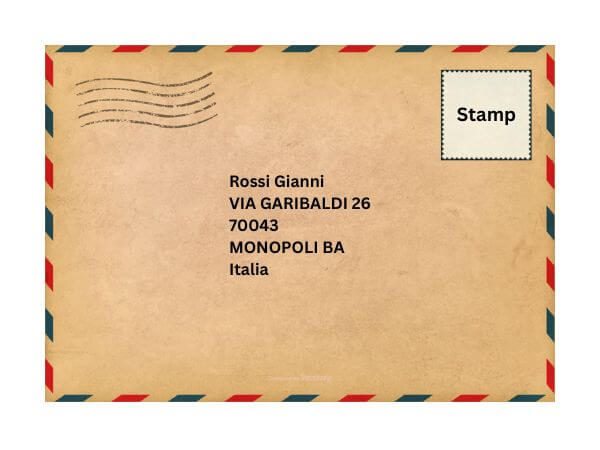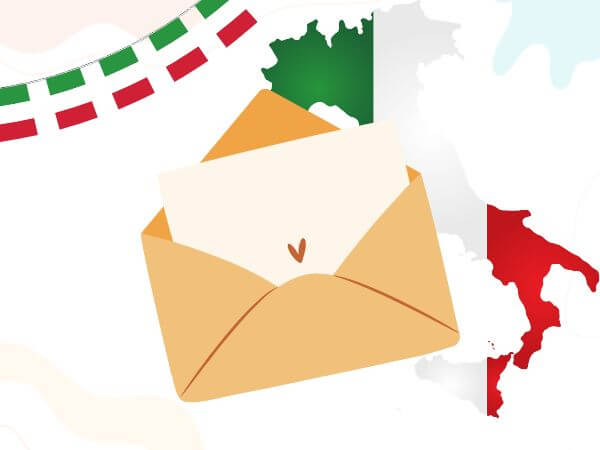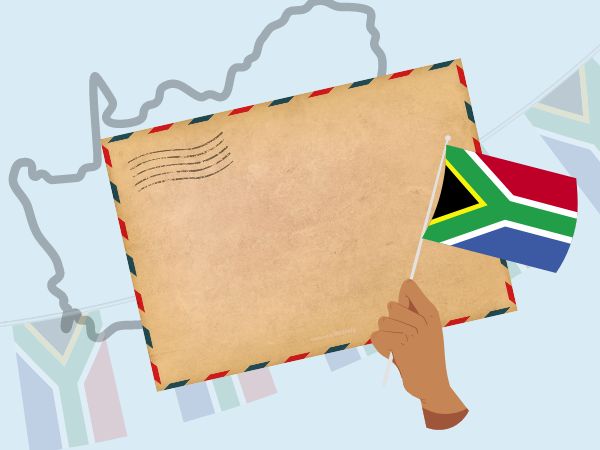Have you ever wanted to send a heartfelt letter to Italy but felt overwhelmed by the process? Sending a letter to an international destination can be tricky, whether it’s for personal or professional reasons. Formatting and address-related errors, cultural misunderstandings, and breaking restrictions unintentionally can cause problems with the timely delivery of your letter.
Fortunately, you can avoid these obstacles by following some simple guidelines. In this article, we will guide you all about sending letters to Italy with ease. You can find the correct format, titles, abbreviations, and a lot more inside.
If you’re looking for the quickest and easiest way to send a real letter to Italy, let us do the heavy lifting. With e-Snail, you can send a physical letter to anywhere in the world.
Italy Address Format
Generally, an Italian address is written in the order of the recipient name, street name followed by house number, postal code and city name. You must follow this exact sequence in order to ensure your letter reaches its destination.
Moreover, you should write the recipient’s address in the centre of the envelope and use clear handwriting. It’s also a good idea to include your return address on the back of the envelope, in the top-left corner, so the letter can be returned in case of any issues.
Italian Abbreviations & Codes
To write a letter with the correct format, you must familiarise yourself with some common abbreviations:
- Via and Viale: In Italian addresses, “Via” is commonly abbreviated as “V.” It represents a street or road. Meanwhile, “Viale” (avenue) is often abbreviated as “V.le.”
- Piazza and Piazzale: “Piazza” is abbreviated as “P.zza” which means public square. Similarly, “Piazzale,” a larger square or open space, is abbreviated as “P.zle.”
- Corso: “Corso” refers to a main street or boulevard and is typically abbreviated as “C.so.”
- Contrada: “Contrada” is a district or neighborhood in rural areas. It is often abbreviated as “C.da.”
- Postal Codes: Italian postal codes consist of five digits and are known as “Codice di Avviamento Postale” (CAP). The first two digits represent the region, while the remaining three indicate the locality or town.
Below are some common abbreviations for cities, along with their respective area codes in Italy:
- Rome: ROM – 06
- Milan: MIL – 02
- Naples: NAP – 081
- Florence: FLR – 055
- Venice: VCE – 041
- Turin: TRN – 011
- Bologna: BLQ – 051
- Genoa: GOA – 010
- Palermo: PMO – 091
- Verona: VRN – 045
The Basic Structure and Components of an Italian Letter
Salutation: Start your letter with a polite greeting, such as “Caro” (Dear), followed by the recipient’s name. You can use the alternative “Carissimo/a” (Dearest) for someone closer to you.
Introduction and Main Body: Start your letter with a brief introduction, expressing why you are writing it to set the context for your message. After the introduction, you can get into the main body that will bear the central information of your letter.
Closing: Wrap up your letter with an appropriate closing. You can use one of these common closings, such as “Cordiali saluti” (best regards), “Distinti saluti” (yours sincerely), or “Affettuosi saluti” (warm regards). Make sure to choose one that matches the tone and formality level of your letter.
Signature: Now, you can sign your name at the end of the letter. You may add a personal touch to an informal letter, such as a postscript (P.S.) with a casual message.
Prohibited and Restricted Items For Mailing to Italy
There are certain restrictions and prohibitions for mailing to Italy. You must be aware of what you can’t send to the country to avoid any issues with custom regulations.
It is prohibited to mail several items to Italy, including illegal substances such as narcotics, weapons, ammunition, explosives, and flammable materials. You also can’t send live animals, perishable food items, and counterfeit goods. Moreover, hazardous materials, important heritage items, cultural artefacts or obscene items are also not allowed.
Even several prescription medications are restricted, along with alcohol, tobacco, and some agricultural products. To send any of these items, you need to familiarise yourself with the specific regulations. You might also have to get the necessary permits or licenses and ensure proper packaging of the material.
Conclusion
While sending a letter is a simple task, there are some crucial steps involved that must be followed. You need to understand the basic format and structure of sending a letter to Italy, along with the proper salutations.
It is essential to use a respectful and polite tone, no matter who you are addressing. Moreover, end the letter with an appropriate closing. Also, make sure to add the required stamps and choose the right postal service. You must also be aware of the custom regulations for sending mail to Italy to ensure you are not breaking any rules.
Don’t forget, you can also use e-Snail to easily send a physical letter online to anywhere in the world, including Italy.




